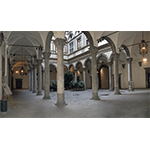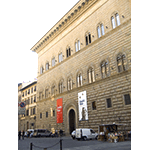Gabinetto Vieusseux [Cabinet Vieusseux]
Founded in 1819 by Giovan Pietro Vieusseux in Palazzo Buondelmonti in Piazza Santa Trinita, the "Scientific and Literary Cabinet" became a reference point in the panorama of Italian nineteenth-century culture. Providing an excellent reading service, which ensured the availability of a great number of Italian and foreign periodicals, it was immediately enriched by an ample circulating library.
In 1820 Vieusseux founded "L'Antologia", a periodical of intellectual and political commitment, which was then suppressed by Leopoldo II in 1833. A substantial section of the review was dedicated to the natural sciences, to geography and to travel. It published, among other things, the physiological studies of Edwards; precise information on the activity of the Medical-Surgical Association; the formerly unpublished writings of Antonio Cocchi on Asclepiades from 1824; as well as works by Volta, Matteucci, Paolo Savi, Raddi, Repetti, Inghirami, and J. Graeberg of Hemsoe. Great attention was focused on agrarian problems, with articles by C. Ridolfi, F. Tartini Salvatici, and G. Capponi, while starting in 1823 it published a "scientific bulletin" compiled by Gazzeri containing information on the work of the most important Italian and foreign academies. Vieusseux also published other important newspapers, among them the "Giornale Agrario Toscano" compiled by Raffaello Lambruschini, Cosimo Ridolfi and Lapo de' Ricci and published starting in 1827. In 1824 Vieusseux, Giovanni Inghirami and Emanuele Repetti were among the founders of the "Tuscan Society of Geography, Statistics and Natural History of Italy" and in 1841 Vieusseux was one of the organisers of the assembly of Italian scientists held in Florence.
The beautiful Library, which already by 1837 possessed over 12,000 volumes, can boast today a heritage of some 300,000 monographs and 1800 periodicals. Among the most significant parts are the Fiammetta Olschki Collection (collection of books of travel in Europe from the 16th to the 19th century, conserved at the Romantic Centre), the collection donated by the orthopaedic surgeon Pietro Palagi and the group of medical publications belonging to the physician Giovanni Battista Roatta.
The Gabinetto retains its original spirit and scope, basically unchanged. In the course of its history it has occupied various sites: Palazzo Buondelmonti (1819-1873); Palazzo Feroni (1873-1898); Palazzo in Via Vecchietti (1898-1923); and Palazzo di Parte Guelfa (1923-1939). Since 1939 it has been located in Palazzo Strozzi. The construction of this imposing edifice was begun in the second half of the 15th century for Filippo Strozzi, who commissioned the project of Benedetto da Maiano. It was however Simone del Pollaiolo, known as Cronaca, who best fulfilled the ambitious plans of Strozzi. The Palace, meeting place of intellectuals, provided accommodations for the entire grand-ducal family on the occasion of a meeting of the members of the Accademia della Crusca that took place in 1652. When the Strozzi family moved to Rome, the prestigious residence ceased to serve its function of representation around the middle of the 19th century, with the restoration of the Lorraines. The palace remained the property of the Strozzi family until 1937, when it was sold to the National Insurance Institute, which was responsible for its overall restoration. Today its halls, in addition to housing the Gabinetto Scientifico Letterario Viesseux [Viesseux Scientific and Literary Cabinet], are used for major exhibitions as well as by other institutions, such as the Istituto di Studi sul Rinascimento [Institute for Renaissance Studies], founded in 1937.
****************************
Texts by Alessandro Tosi
English translation by Catherine Frost
Last update 26/mar/2008





